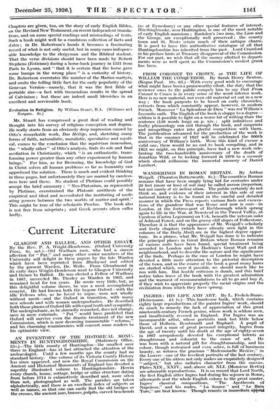WANDERINGS IN ROMAN BRITAIN. By Arthur Weigall. (Thornton Butterworth. 6s.)—The
countless Roman remains that have been snugly lying hid for centuries under 20 feet (more or less) of soil may be called aurum irrepertum, but not surely et sic meting situnt. The public certainly do not think so, and evidence of their interest in this side of our national history is to be found in the careful and detailed manner in which the Press reports various finds and excava- tions of the grandeur that was Rome and now is ours—in London, at the fortress-port of Richborough which sprang again to life in the War, at Newstead in the Tweed Valley, at Caerleon (Castra Legionum) on Usk, beneath the veteran oaks of Ashtead Forest, and on the grassy cliff slopes of Folkestone. Therefore it is that the appearance of Mr. Weigall's scholarly and lively chapters (which have already seen light in the columns of the Daily Mail) are in the highest degree oppor- tune. In a phrase, what Mr. Weigall has done is to indicate the principal places in Great Britain where Roman remains of various sorts have been found, special treatment being accorded to London and to Hadrian's Great Wall and its neighbourhood, and to describe the nature and the significance of the finds. Perhaps in the case of London he might have devoted a little more attention to the pictorial description of the town, and in the course of the book a good many hares are started which, were it possible, we should much like to run with him. But hostile criticism is dumb, and this brief notice takes leave of the book with tl:e greatest admiration and the warmest of recommendations to all to go and buy it, if they wish to appreciate properly the racial origins and the civilization from which they have sprung.


































 Previous page
Previous page